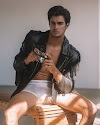


This is a scene from ALADDIN (images all copyright Disney) where I learned as much philosphically as I did technically. I was the supervising animator on the parrot character (voiced by the inimitable Gilbert Gottfried). This is the first time in the movie when we see clearly that he has merely been pretending to be a typical squawking beast and is actually a sentient co-conspirator with the villain (animated by Andreas Deja). The sleazy little thief (animated by T. Dan Hoffstead) is going off into the mouth of the cave as the parrot squawks in typical fashion behind him. Just when he gets out of earshot, the bird drops the "act" and mutters to Jafar: "Jeez, where'd ya dig this bozo up?" The audience is at that point let in on the character's two-faced nature.
The storyboard showed this as a static medium closeup, with the characters facing the audience which suited me fine. The theif was supposed to exit the frame and we'd push in a bit to watch Iago 'change' from dumb to smart. Directors John Musker and Ron Clements instead chose an "over the shoulder" shot that would rotate about 45 degrees behind the villains during the dialog and then push past them into the "cave of wonders." I immediately started protesting when I got the layout (frame by frame printouts of the rotaing BG with stand-ins for the characters). Doesn't it say somewhere in one of Frank & Ollie's bibles that you should never be in motion while a character is changing expression? Or even worse, be on their backs instead of their faces? Here we had an integral moment when the guy's whole personality is going to change and I kept saying it wouldn't work, it was technically impossible. I wanted to stick with the simpler composition. I must have bellyached for the better part of a week about it and was going to the mat. Finally Musker looked me in the eye and said: "Just try it this way and if it doesn't work we can do it over." He said it quietly, he said it diplomatically, but something in his tone made me hear what I think he really meant:
"Quit being a diva and do it the way we told you or we'll give it to someone else."
I realized in that moment that this was a pretty revolutionary CGI shot for the time and a lot of expense had been spent on it. I also realized that an animator who wasn't clinging to some dogmatic rule might do the scene instead and knock it out of the park. Then I'd not only look stupid, but I'd be mad at myself for letting a great scene go. I jumped into it with enthusiasm and relish and turned it around relatively fast. It turned out to be directorally a very good choice, the shift in point of view not only didn't wreck the parrot's moment, it actually emphasized it, making it all the more conspiratorial. Among other things, being that close toward the end gave me the chance to "squeeze" Iago's pupils as he crossed his eyes on the word "Jeez!" to heighten his contempt for the thief, something that would have been impossible in a medium shot. All I had to do was favor his face to the camera a bit as he turned back to look at Jafar. I had a lot of fun animating it and was embarassed I had crabbed so much about doing it this way.
I've noticed that one of the things that separates the pro's from the dillitantes in everything, acting, music whatever is their ability to say "yes" much more quickly than "no." There are a lot of things that have more than one solution. There is also a lot of dogma that shouldn't be clung to. When I really can't understand a direction (or find it hopelessly counter-productive) then I still balk, but I have tried to be a whole lot more open-minded since then. You don't want to be the one who figured out how not to do something (pretty much anybody can do that); try whenever possible to be the one who got it right.
And don't believe everything you read in books.




0 Yorumlar